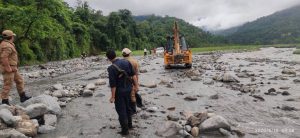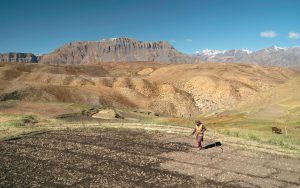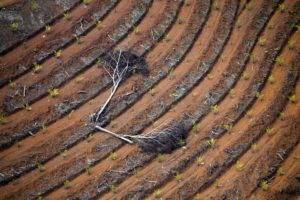As the 2020 monsoon entered Bihar on June 14, millions of residents worried that this year’s flooding would be catastrophic. Flood-control measures in the state in eastern India have been delayed due to the lockdown forced by the Covid-19 pandemic. And the work that has been done in a hurry may turn out to be sub-standard.
Northern Bihar is flooded almost every year as the rain-swollen tributaries of the River Ganga rush down from adjacent Nepal. In 2019, the floods killed 238 people and thousands of livestock, forced thousands to flee and ruined crops. Much of the state capital Patna was flooded for over a fortnight; more than a million people in the city were affected.
![two boys float on tyres and wood across the water. Much of Patna, the capital of Bihar, was flooded for over a fortnight last year [image by: Louise Batalla Duran/Alamy]](https://dialogue.earth/content/uploads/2020/06/Bihar-floods-Patna-Louise-Batalla-Duran-Alamy-Stock-Photo.jpg)
But even before the recent political tensions, the lockdowns in both India and Nepal had affected flood-control preparations.
In normal years, engineers and workers from India carry out embankment repairs and other flood-control works on the Nepal side of the border under a relatively informal agreement between the government of Nepal and the Bihar state government. “This year, due to the lockdowns in both India and Nepal, the state government could get a nod from the Nepal government only after India’s central government intervened,” said Sanjay Jha, the minister of water resources in Bihar.
Shashi Kant Sinha, executive engineer at the Water Resources Department (WRD) said, “Authorities in Nepal were not allowing entry of workers and officials for the work along the rivers that crossed into Bihar. It posed a challenge to complete different projects for flood control.”
But the bigger worry stems from the situation within Bihar, where 76% of the northern part of the state and 73% of the southern part are flood-prone. The annual job of repairing river embankments came to a halt with the country-wide lockdown on March 25, and work could only start in mid-May as the lockdown was eased.
Dinesh Prasad, an official of the state government department that looks after flood-control planning, confirmed that the lockdown brought all repair and maintenance work to a halt. “A lot of time was wasted due to the lockdown to contain the Covid-19 pandemic. Officers, engineers and field staff were helpless as workers and contractors engaged in projects for embankment repair, maintenance and anti-erosion work left the sites out of fear of the pandemic,” he told The Third Pole.
In November 2019, the Bihar State Flood Control Board had cleared 122 projects to repair and strengthen embankments, but the work has been delayed and the deadline for completion have been changed repeatedly.
A WRD official said, “The anti-erosion work was supposed to be completed by May 15. First the deadline was extended to May 31. But the work could not be completed, and the department instructed officials to complete the work before the monsoon arrives.”
The current deadline is June 20. Officials had hoped that the monsoon – which brings over 80% of the annual rainfall to South Asia between June and September – would be delayed until then.
Minister Jha admitted, “Execution on the ground was a big challenge. Later, the government put more resources to complete the work. Anti-erosion work was affected due to lack of supplies of materials during the lockdown, including sand-filled bags and crates.”
Jha claimed that most of the work on the Indian side of the border was completed by the first week of June. However, a senior official in his department said Jha had held a meeting on June 11 to review flood-control measures, during which officials said they had completed 277 of the 388 anti-erosion and flood protection works – a little over 71%.
Vulnerable points unprotected
Another official in the same department said work at vulnerable points on the western Kosi embankment at Kanhauli in Supaul district, bordering Nepal’s Saptari district, was incomplete. He said he hoped it would be completed by June 15.
Rajeev (who only uses one name), a river activist based in Bihar, said the work that had been completed was done, “on paper and in a hurry. This year people will face a major devastation if floods hit them because the department has utilised funds for anti-erosion and flood protection works in other projects.”
Bihar has 17.2% of India’s flood-prone land. Of the 38 districts in the state, 28 are flood-prone. Since the 1950s, authorities have been trying to solve the problem by building and then raising embankments along the rivers. Bihar now has 3,745.96 kilometres of embankments.
See: Flawed embankment strategy converts Bihar into watery grave
This has meant that the rivers flowing down from the Himalayas have not been able to spread the huge amount of silt they carry on surrounding lands through small floods.
The silt accumulates in the riverbeds year after year, reducing the amount of water most rivers in northern Bihar can contain. This has made the entire region even more flood-prone. What is worse, when the rivers flow over the embankments – as they do almost every monsoon – the flood waters cannot drain away.
For eight months of the year the water in Bihar’s rivers flows through a few braided channels on a wide riverbed. But during the four monsoon months, the water volume multiplies by many times, and flows down the entire riverbed. When such a flow of water encounters embankments, it often either spills over or the entire river changes course, rendering the whole embankment-building exercise futile. This has repeatedly caused devastating floods along the Kosi, one of the largest tributaries of the Ganga.
See: New bridge over troubled Kosi raises flood risk
Disaster management
This year, the State Disaster Management Authority (SDMA) of Bihar has already asked for boats to be kept on standby to rescue people who may be trapped by floodwaters. This bit of advance planning is a first in the state. The SDMA has prepared evacuation plans and earmarked spots where relief camps can be set up, with enough space to ensure social distancing during the pandemic. It has asked district officials to make sure masks, hand sanitiser and soap are available in the camps.
Meanwhile, the issue of managing flooding in Patna is in limbo. A state-owned corporation spent INR 1.67 billion (about USD 22 million) to strengthen the drainage system and buy submersible pumps, diesel generators and diesel pumps for the 66 existing and temporary drainage pumping stations, which were supposed to be installed by July this year. The urban development minister of Bihar has ordered an inquiry into this purchase. No work has started on a long-awaited detailed project report to overhaul the city’s drains on a more long-term basis.
Regardless, the rain has started and so has the waterlogging. Ram Kripal Yadav, who represents Patna in India’s parliament, wrote to the state’s chief minister Nitish Kumar, asking, “What is the use of spending crores [tens of millions] in the name of de-silting the drains when a brief spell of rain can turn the city into islands?”
Elections to the Bihar state assembly are due later this year. It remains to be seen if the state government will manage to deal with the floods that may occur before the polls, or blame Covid-19 and Nepal for its lack of preparedness.
![<p>Flooding of the River Bagmati, a tributary of the Ganga, in Bihar [image by: Joerg Boethling/Alamy]</p>](https://dialogue.earth/content/uploads/2020/06/Bihar-floods-Bagmati-Joerg-Boethling-Alamy-Stock-Photo.jpg)







![Open-cast coal mines of the Mahanadi Coal Fields Limited at Jharsuguda, Orissa [image: Alamy]](https://dialogue.earth/content/uploads/2020/06/FFXRKT-300x194.jpg)